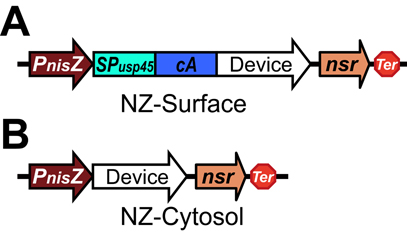Difference between revisions of "Part:BBa K1887002"
(→Design) |
|||
| Line 22: | Line 22: | ||
===Design=== | ===Design=== | ||
The NZ9000 strain (nisKR integrated) can not tolerate high level of nisin concentration. We inferred that the integration of the nisI or nsr gene into the genome of NZ9000 might render it to tolerate high levels of nisin concentration while maintain the gene expression capacity of the NICE system. To achieve this goal, we constructed two plasmids to test whether the incorporation of nisI or nsr can really increase the nisin tolerance of NZ9000 and NZ-Blue. The expression of nisI or nsr gene is driven by the P32 promoter, which is a constitutive promoter. By this way, the NICE system will be optimized. | The NZ9000 strain (nisKR integrated) can not tolerate high level of nisin concentration. We inferred that the integration of the nisI or nsr gene into the genome of NZ9000 might render it to tolerate high levels of nisin concentration while maintain the gene expression capacity of the NICE system. To achieve this goal, we constructed two plasmids to test whether the incorporation of nisI or nsr can really increase the nisin tolerance of NZ9000 and NZ-Blue. The expression of nisI or nsr gene is driven by the P32 promoter, which is a constitutive promoter. By this way, the NICE system will be optimized. | ||
| + | |||
| + | [[file:cA1.jpg]] | ||
===Results=== | ===Results=== | ||
Revision as of 07:59, 14 October 2016
NSR
Nisin is a 34-residue antibacterial peptide and a widely used food preservative because of its potent bactericidal activity against a variety of food spoilage bacteria. However, the bactericidal effect of nisin has been compromised by the occurrence of nisin resistance in various bacteria. Nisin resistance in the nisin nonproducer L. lactis subsp. diacetylactis DRC3 was reported to be conferred by a specific nisin resistance gene (nsr).
Sequence and Features
- 10COMPATIBLE WITH RFC[10]
- 12COMPATIBLE WITH RFC[12]
- 21COMPATIBLE WITH RFC[21]
- 23COMPATIBLE WITH RFC[23]
- 25COMPATIBLE WITH RFC[25]
- 1000COMPATIBLE WITH RFC[1000]
Usage and Biology
Background
Besides as the NICE system inducer, nisin is also a 34-residue antibacterial peptide produced by L. lactis that is active against a wide range of gram-positive bacteria and is therefore extensively used in the food industry as a preservative. Nisin inhibits growth of Gram-positive cells in two ways. First, it will inhibit cell wall synthesis by binding to the lipid II molecule in the membrane. Second, nisin molecules can span across the lipid bilayer, creating a pore in the cell wall which causes the cell to lysis. Because of these reasons, the L. lactis NZ9000 strain can not tolerate high levels of nisin concentration in the medium.
In nisin producing strains, the nisin operon contains four nisin immunity genes, nisI, nisF, nisE and nisG. Among them, nisI encodes a lipoprotein that serves as the first defense, and is therefore always present in the cell with nisin immunity. NisF, NisE, and NisG form an ABC-exporter system, which provides the extra immunity and presents in the cell when nisin is encountered in the environment. In non-nisin-producing L. lactis, nisin resistance could be conferred by a specific nisin resistance (nsr) gene, which encodes a 35-kDa nisin resistance protein (NSR). NSR could proteolytically inactivate nisin by removing six amino acids from the carboxyl “tail” of nisin. The truncated nisin (nisin 1–28) displayed a markedly reduced affinity for the cell membrane and showed significantly diminished pore-forming potency in the membrane. A 100-fold reduction of bactericidal activity was detected for nisin 1–28 in comparison to that for the intact nisin. What’s more, the truncated nisin can still induce gene expression through the NICE system. Thus incorporation of the nisI or nsr gene into the NICE system will lead to tolerance of high levels of nisin concentration but do not have to sacrifice the gene expression capacity of the NICE system.
Design
The NZ9000 strain (nisKR integrated) can not tolerate high level of nisin concentration. We inferred that the integration of the nisI or nsr gene into the genome of NZ9000 might render it to tolerate high levels of nisin concentration while maintain the gene expression capacity of the NICE system. To achieve this goal, we constructed two plasmids to test whether the incorporation of nisI or nsr can really increase the nisin tolerance of NZ9000 and NZ-Blue. The expression of nisI or nsr gene is driven by the P32 promoter, which is a constitutive promoter. By this way, the NICE system will be optimized.
Results
The two plasmids were successfully constructed, and then they were transformed into NZ9000. After that we determined the growth curve of NZ9000, NZ-pNisI, NZ-pNsr under different concentrations of nisin. As shown in Fig 2.3, without nisin, the growth curve of these 3 strains exhibits no difference. However, under 200IU/mL nisin concentration, the growth of NZ9000 is severely inhibited, the NZ-pNisI strain can still grows to a moderate level, while the NZ-pNSR strain can still grow to a level similar to that without nisin, which means the NSRprotein can protect L. lactis at high nisin concentrations, while the protect efficiency of NisI is not as pronounced as NSR. Finally, under 500 IU/mL nisin concentration, only the NZ-pNSRstrain can still grow, the NZ9000 and NZ-pNisI strain did not grow.
References
[1] Hacker, C., Christ, N.A., Duchardt-Ferner, E., Korn, S., Gobl, C., Berninger, L., et al. (2015). The Solution Structure of the Lantibiotic Immunity Protein NisI and Its Interactions with Nisin. J Biol Chem 290, 28869-28886.
[2] Khosa, S., Lagedroste, M., and Smits, S.H. (2016). Protein Defense Systems against the Lantibiotic Nisin: Function of the Immunity Protein NisI and the Resistance Protein NSR. Front Microbiol 7, 504.
[3] Sun, Z., Zhong, J., Liang, X., Liu, J., Chen, X., and Huan, L. (2009). Novel mechanism for nisin resistance via proteolytic degradation of nisin by the nisin resistance protein NSR. Antimicrob Agents Chemother 53, 1964-1973.

